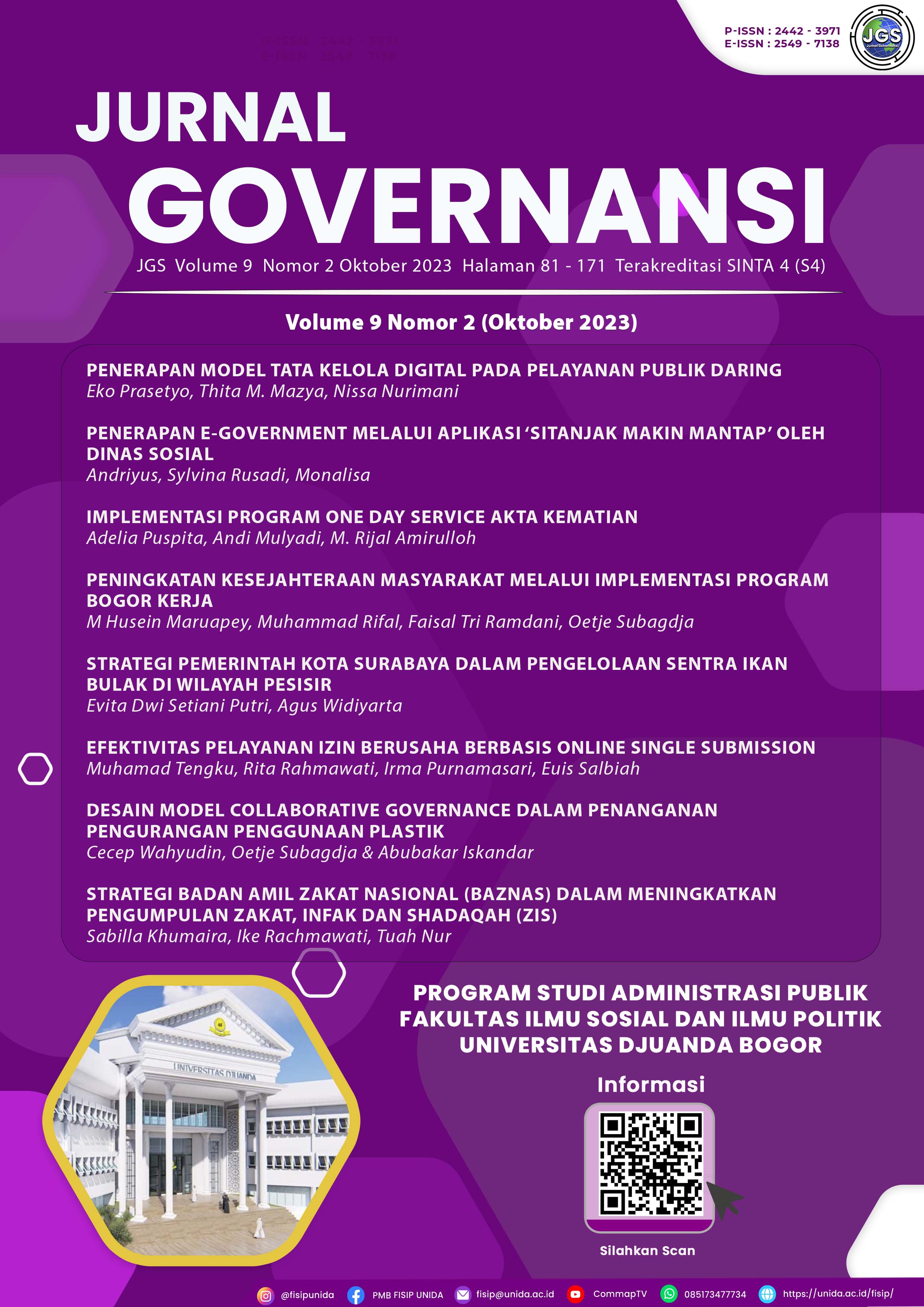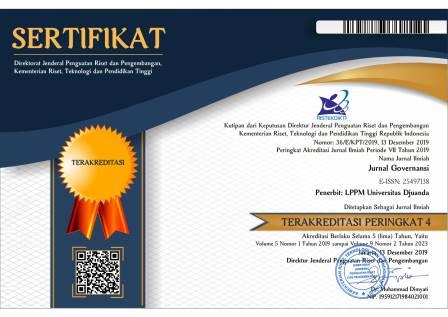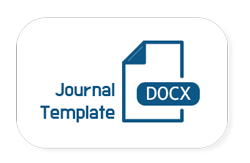E-GOVERNMENT IMPLEMENTATION THROUGH ‘SITANJAK MAKIN MANTAP’ APPLICATION BY SOCIAL OFFICE
DOI:
https://doi.org/10.30997/jgs.v9i2.7219Keywords:
E-Government, Government Innovation, Local GovernmentAbstract
This study intends to describe the implementation of e-government through the Sitanjak Makin Mantap application by the Pekanbaru City Social Office This application is one way of bringing the concept of e-government into practice. E-government is innovation and creativity from the government in implementing all forms of policies to serve the public. However, in the implementation of applications, there are still many issues with application deployment, including a lack of funding for technology infrastructure and even a shortage of human resources. This study carried out observations and interviews in data collection Consequently, it may be stated that the study employed phenomenological-style qualitative research methodologies. The findings of the field study demonstrated that the Pekanbaru City social service's efforts to implement the application were still having difficulties due to ongoing funding and outreach issues, necessitating changes in the areas of support, quality, and value. For researchers who want to conduct research on the same topic, it is recommended to use theory-government.
References
Anggito, A., & Setiawan, J. (2018). Metodologi Penelitian Kualitatif. CV Jejak.
El-Hadadeh, R., Weerakkody, V., & Al-Shafi, H. S. (2010). E-Government Implementation Challenges: A Case Study. AMCIS Proceedings.
Fadli, M. R. (2021). Memahami desain metode penelitian kualitatif. Humanika, Kajian Ilmiah Mata Kuliah Umum, 21(1), 33–54.
Field, Muller, Lau, G.-R. V. (2003). The case for e-government: Excerpts from the OECD report “The E-government Imperative.” OECD Journal on Budgeting, 3(1), 62–96.
Flak, L. S., Dertz, W., Jansen, A., Krogstie, J., Spjelkavik, I., & Ølnes, S. (2009). What is the value of eGovernment–and how can we actually realize it? Transforming Government: People, Process and Policy.
Gunawan, I. (2013). Metode Penelitian Kualitatif : Teori dan Praktik. Bumi Aksara.
Hanna, K. N. (2010). Transforming Government and Building the Information Society: Challenges and Opportunities for the Developing World. In Springer New York.
Indrajit, R. E. (2002). Electronic Government: Strategi Pembangunan dan Pengembangan Sistem Pelayanan Publik Berbasis Teknologi Digital. Andi Offset.
Indrajit, R. E. (2005). E-Government In Action. Andi Offset.
Kumar, V., Baskher, M., & Irvan, B. (2007). Factors for successful e-government adoption: a conceptual framework. The Electronic Journal of E-Government, 5(1), 122–133.
Rozikin, M., Hesty, W., & Sulikah, S. (2020). Kolaborasi dan E-Literacy: Kunci Keberhasilan Inovasi E-Government Pemerintah Daerah. Jurnal Borneo Administrator, 16(1), 61–80.
Scott, M., DeLone, W., & Golden, W. (2016). Measuring eGovernment success: a public value approach. European Journal of Information Systems, 25(3), 187–208.
Sudirman, F. A., & Saidin, S. (2022). Pemerintahan Berbasis Elektronik (E-Government) dan Pembangunan Berkelanjutan: Reviu Literatur Sistematis: Reviu Literatur Sistematis. Nakhoda: Jurnal Ilmu Pemerintahan, 21(1), 44–58.
Surendo, K. (2009). Implementasi tata kelola teknologi informasi (Cetakan I). Informatika.
Downloads
Published
How to Cite
Issue
Section
License
Copyright (c) 2023 Sylvina Rusadi, Andriyus, Monalisa

This work is licensed under a Creative Commons Attribution-ShareAlike 4.0 International License.
Authors who publish with Jurnal Governansi agree to the following terms:
- Authors retain copyright and grant the journal right of first publication with the work simultaneously licensed under a Creative Commons Attribution 4.0 International License that allows others to share the work with an acknowledgement of the work's authorship and initial publication in Jurnal Governansi.
- Authors are able to enter into separate, additional contractual arrangements for the non-exclusive distribution of the journal's published version of the work (e.g., post it to an institutional repository or publish it in a book), with an acknowledgement of its initial publication in Jurnal Governansi.
- Authors are permitted and encouraged to post their work online (e.g., in institutional repositories or on their website) prior to and during the submission process, as it can lead to productive exchanges, as well as earlier and greater citation of published work.



















